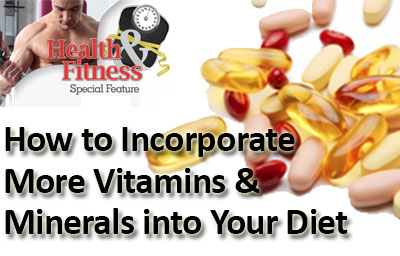
America is a fast food nation, and it’s no surprise that a lot of the choices we make when we’re out and about are not only bad choices to begin with, but there are few, if any, net positives about them either. As a result, we are some of the most overfed people in the world, but also some of the most malnourished. How do we fix that? It’s easy: we choose foods that have the proper “micronutrients.” Those are the vitamins and minerals the body needs most.
The Department of Agriculture says we don’t get enough calcium, potassium, magnesium, and  key vitamins in our diets. Here’s what you need to know to make a positive change in your diet.
key vitamins in our diets. Here’s what you need to know to make a positive change in your diet.
An average adult who eats 2,000 calories a day, according to the Department of Agriculture, should be consuming 1,136 milligrams of calcium in that day. How do you know you’re getting enough? To give you an idea, an eight-ounce cup of nonfat yogurt offers anywhere from 350 to 450 milligrams of calcium. Eat one of those and you’re a third of the way to making sure you have enough calcium for the day. Milk offers about 300 milligrams per cup, and you can get 150 milligrams from eating 1/2 cup of spinach and 100 milligrams from eating one packet of instant oatmeal. Sounds simple enough, right?
Then we get to potassium. This is the nutrient that the Department of Agriculture says that  Americans are missing out on the most. They say that we should be taking in approximately 4,000 milligrams of potassium per day. What foods are rich in potassium? You’d be right if you guessed the banana. A medium-sized banana offers over 400 milligrams of potassium right there. But you can’t just eat ten bananas a day! More diversified options for potassium include beans (anywhere between 350-600 milligrams per serving), tomatoes (have some spaghetti tonight, because 1/4 cup of tomato paste gives you 664 milligrams of potassium), and potatoes (anywhere between 600-700 milligrams per potato).
Americans are missing out on the most. They say that we should be taking in approximately 4,000 milligrams of potassium per day. What foods are rich in potassium? You’d be right if you guessed the banana. A medium-sized banana offers over 400 milligrams of potassium right there. But you can’t just eat ten bananas a day! More diversified options for potassium include beans (anywhere between 350-600 milligrams per serving), tomatoes (have some spaghetti tonight, because 1/4 cup of tomato paste gives you 664 milligrams of potassium), and potatoes (anywhere between 600-700 milligrams per potato).
Adults should be consuming just under 400 milligrams of magnesium per day. This isn’t something people think about much, and luckily it is easy to get your required daily intake. You can find 150 milligrams of magnesium in just one ounce of pumpkin! Bran cereal also offers over 100 milligrams per ounce. Beans offer anywhere between 45 and 75 milligrams per half-cup. Brown rice and tofu are similarly rich in magnesium. Snack on some peanuts too: one ounce equals 50 milligrams of magnesium.
can find 150 milligrams of magnesium in just one ounce of pumpkin! Bran cereal also offers over 100 milligrams per ounce. Beans offer anywhere between 45 and 75 milligrams per half-cup. Brown rice and tofu are similarly rich in magnesium. Snack on some peanuts too: one ounce equals 50 milligrams of magnesium.
Vitamin A is critical in cell development, which helps maintain the heart, kidneys and lungs, and it also plays an important role in vision and how well we see. Adult males need approximately 900 micrograms of vitamin A per day. You’ve probably heard before that carrots help you see better, and they’re not wrong; nearly 2/3 of your vitamin A allowance is taken care of if you eat 1/2 cup of carrots. Spinach offers a similar amount of vitamin A, and if you eat one medium sweet potato, you have more than enough vitamin A for the entire day!
Vitamins C and E help form strong bones and fight damage to cells, respectively. Adult males  need roughly 90 milligrams of vitamin C and 15 milligrams of vitamin E each day. Many fruits and vegetables offer more than 100% of your daily supply of vitamin C, such as guavas and raw red peppers. Oranges, which are most commonly associated with vitamin C, offer more than 75% of the vitamin C you need in your diet if you eat one each day. Nuts and seeds are the best way to get your vitamin E. Two ounces of sunflower seeds or two ounces of almonds are all you need to get the vitamin E you need for the day. You can also find 2 to 3 milligrams in each serving of avocado, spinach, and tomatoes.
need roughly 90 milligrams of vitamin C and 15 milligrams of vitamin E each day. Many fruits and vegetables offer more than 100% of your daily supply of vitamin C, such as guavas and raw red peppers. Oranges, which are most commonly associated with vitamin C, offer more than 75% of the vitamin C you need in your diet if you eat one each day. Nuts and seeds are the best way to get your vitamin E. Two ounces of sunflower seeds or two ounces of almonds are all you need to get the vitamin E you need for the day. You can also find 2 to 3 milligrams in each serving of avocado, spinach, and tomatoes.
Ways to Track Your Vitamin and Mineral Intake
There are quite a few different apps you can download from the App Store or Google Play which will help you track your vitamin and mineral intake right on your smartphone. The most popular app that tracks the nutrients going into your body is one called “Cronometer.” Available in free and paid versions, not only will Cronometer track calcium, potassium, magnesium, and ![]() important vitamins like A, C and E, it will track 60 more for you as well, making you feel at ease knowing that your diet truly is well-balanced. Other apps to consider include Vitamin Complete, which figures out your nutrient intake based on your food diary, and the Nutrition Journal’s Vitamin and Mineral Tracker, which will also track your calorie intake and adjust your nutrient guidelines accordingly.
important vitamins like A, C and E, it will track 60 more for you as well, making you feel at ease knowing that your diet truly is well-balanced. Other apps to consider include Vitamin Complete, which figures out your nutrient intake based on your food diary, and the Nutrition Journal’s Vitamin and Mineral Tracker, which will also track your calorie intake and adjust your nutrient guidelines accordingly.
If you’re interested in trying Cronometer on your computer, visit cronometer.com. You can learn more about vitamins and minerals and how to incorporate them into your diet by reading the current national guidelines from the CDC. Go to cdc.gov/nutrition/everyone/basics/vitamins.















